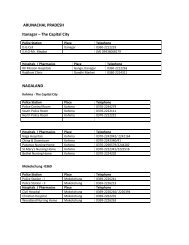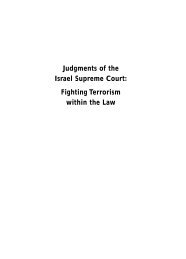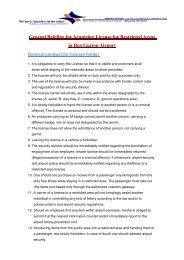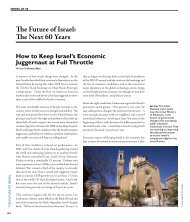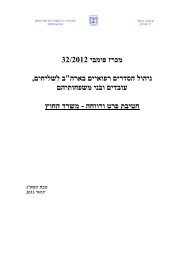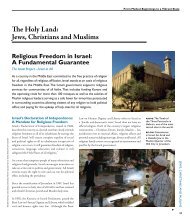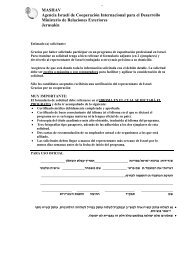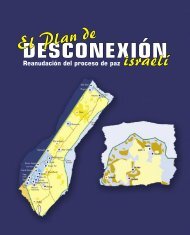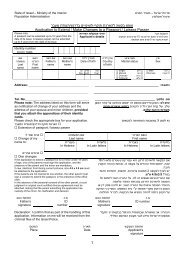Judgments of the Israel Supreme Court: Fighting Terrorism within ...
Judgments of the Israel Supreme Court: Fighting Terrorism within ...
Judgments of the Israel Supreme Court: Fighting Terrorism within ...
Create successful ePaper yourself
Turn your PDF publications into a flip-book with our unique Google optimized e-Paper software.
<strong>the</strong> obstacle upon <strong>the</strong> mountain will prevent its taking by terrorists. The<br />
respondent surveyed <strong>the</strong> relevant area, and came to <strong>the</strong> conclusion that <strong>the</strong> route<br />
proposed by <strong>the</strong> petitioners is considerably topographically inferior, and will<br />
endanger <strong>the</strong> forces that will patrol along <strong>the</strong> fence. In order to reduce <strong>the</strong> injury<br />
to <strong>the</strong> local inhabitants, <strong>the</strong> military commander decided that agricultural gates<br />
be built. One daytime gate will be built south <strong>of</strong> Beit Likia. Ano<strong>the</strong>r daytime<br />
gate will be built three kilometers from it (as <strong>the</strong> crow flies), north <strong>of</strong> Beit<br />
Anan. Specific requests by farmers will be examined on <strong>the</strong>ir merits. Owners <strong>of</strong><br />
land seized will be compensated, and olive trees will be transferred ra<strong>the</strong>r than<br />
uprooted. The route has even taken into consideration buildings built illegally<br />
by Palestinian inhabitants in <strong>the</strong> area, since <strong>the</strong>re was not enough time to take<br />
<strong>the</strong> legal steps necessary for <strong>the</strong>ir demolition. We were fur<strong>the</strong>r informed that it<br />
was decided, during <strong>the</strong> survey which took place onsite with <strong>the</strong> participation <strong>of</strong><br />
<strong>the</strong> petitioners’ counsel, to make a local correction in <strong>the</strong> route <strong>of</strong> <strong>the</strong> obstacle,<br />
adjacent to <strong>the</strong> village <strong>of</strong> Chirbet Abu A-Lahm, which will distance <strong>the</strong><br />
obstacle from <strong>the</strong> houses <strong>of</strong> <strong>the</strong> village. We originally prohibited (on February<br />
29, 2004) works to erect <strong>the</strong> separation fence in <strong>the</strong> part <strong>of</strong> <strong>the</strong> route to which<br />
<strong>the</strong> abovementioned orders apply. During <strong>the</strong> hearing (on March 31, 2004),<br />
we ordered <strong>the</strong> cancellation <strong>of</strong> <strong>the</strong> temporary injunction with respect to <strong>the</strong><br />
segment between <strong>the</strong> Beit Chanan riverbed and <strong>the</strong> ascent to Jebel Muktam.<br />
56. From a military standpoint, <strong>the</strong>re is a dispute between experts<br />
regarding <strong>the</strong> route that will realize <strong>the</strong> security objective. As we have noted,<br />
this places a heavy burden on <strong>the</strong> petitioners, who ask that we prefer <strong>the</strong><br />
opinion <strong>of</strong> <strong>the</strong> experts <strong>of</strong> <strong>the</strong> Council for Peace and Security over <strong>the</strong> approach<br />
<strong>of</strong> <strong>the</strong> military commander. The petitioners have not carried this burden. We<br />
cannot – as those who are not experts in military affairs – determine whe<strong>the</strong>r<br />
military considerations justify laying <strong>the</strong> separation fence north <strong>of</strong> Jebel<br />
Muktam (as per <strong>the</strong> stance <strong>of</strong> <strong>the</strong> military commander) or whe<strong>the</strong>r <strong>the</strong>re is<br />
no need for <strong>the</strong> separation fence to include it (as per <strong>the</strong> stance <strong>of</strong> petitioners’<br />
and <strong>the</strong> Council for Peace and Security). Thus, we cannot take any position<br />
regarding whe<strong>the</strong>r <strong>the</strong> considerations <strong>of</strong> <strong>the</strong> military commander, who wishes<br />
to hold topographically controlling hills and thus prevent “flat-trajectory”<br />
fire, are correct, militarily speaking, or not. In this state <strong>of</strong> affairs, <strong>the</strong>re is<br />
no justification for our interference in <strong>the</strong> route <strong>of</strong> <strong>the</strong> separation fence from<br />
a military perspective.<br />
57. Is <strong>the</strong> injury to <strong>the</strong> local inhabitants by <strong>the</strong> separation fence in this<br />
segment, according to <strong>the</strong> route determined by <strong>the</strong> respondent, proportionate?<br />
46



